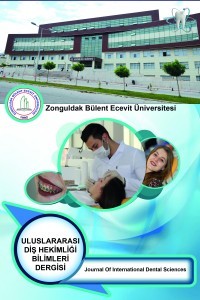Farklı Nikel Titanyum Eğelerin Eğimli Kanallarda Apikal Debris Taşkınlıklarının Değerlendirilmesi
Bu çalışmada farklı eğelerin, eğimli kanallarda enstrümantasyon sonrasında oluşturdukları debris taşkınlığı miktarları incelenmiştir. Alt çene birinci büyükazı dişlerinin eğimli mezial kökleri XP-endo Shaper, HyFlex, ProTaper Next, TF-Adaptive ve 2Shape kullanılarak şekillendirildi. Tüm işlemler 35°C’de uygulandı. Taşan debris miktarı önceden ağırlıkları ölçülmüş olan Eppendorf tüplerinde toplandı. Tüpler debris ağırlığının elde edilmesi için işlem sonrasında tekrar ölçüldü. Taşan debris miktarı boş tüpün ağırlığının işlem sonrası debris içeren tüp ağırlığından çıkarılması ile hesaplandı. Tüm eğeler apikal debris taşkınlığına neden oldu. Gruplar arasında anlamlı fark bulunmadı. 2Shape eğeleri en yüksek ortalama debris taşkınlığı gösterirken, TF-Adaptive eğeler en düşük değerleri gösterdi (P>0.05). Eğe sistemleri veya enstrümantasyon kinematiklerinin eğimli kanallarda apikal debris taşkınlığını anlamlı olarak azaltmadığı tespit edildi.
Anahtar Kelimeler:
apikal debris taşkınlığı, adaptif hareket, kontrol memory, eğimli kanal, nikel titanyum eğe
Evaluation of Nickel Titanium Instruments on Apical Debris Extrusion in Curved Canals
This study evaluated the amount of debris extrusion after instrumentation with various instruments in curved root canals. Curved mesial roots of mandibular first molar teeth were instrumented using XP-endo Shaper, HyFlex, ProTaper Next, TF-Adaptive, and 2Shape instruments. All procedures were performed at 35°C. The extruded debris was collected into pre-weighed Eppendorf tubes. The tubes were weighed to obtain the weight of the debris. The weight of debris was calculated by subtracting the initial weight of the tube from the final weight. All of the instruments were associated with apical debris extrusion. No significant difference was found between the groups. 2Shape instruments demonstrated the highest mean extrusion value, whereas TF-Adaptive instruments demonstrated the lowest (P>0.05). None of the instrument systems or instrumentation kinematics significantly reduced the amount of apical debris extrusion in curved roor canals.
Keywords:
apical debris extrusion, adaptive motion, controlled memory, curved canal, nickel titanium instrument,
___
- Koçak MM, Çiçek E, Koçak S, et al. Comparison of ProTaper Next and HyFlex instruments on apical debris extrusion in curved canals. Int Endod J 2016; 49: 996-1000.
- Seltzer S, Naidorf IJ. Flare-ups in endodontics: I. Etiological factors. J Endod 1985; 30: 476-81.
- Bürklein S, Schäfer E. Apically extruded debris with reciprocating single-file and full-sequence rotary instrumentation systems. J Endod 2012; 38: 850-2.
- Arıcan Öztürk B, Atav Ateş A, Fişekçioğlu E. Cone-Beam Computed Tomographic Analysis of Shaping Ability of XP-endo Shaper and ProTaper Next in Large Root Canals. J Endod 2020; 46: 437-443.
- De-Deus G, Belladonna FG, Simões-Carvalho M, et al. Shaping efficiency as a function of time of a new heat-treated instrument. Int Endod J 2019; 52: 337-42.
- Available at; http://www.fkg.c/sites/default/files/FKG XP-ndo%20Solutions Brochure EN WEB 201902.pdf. (accessed 20 Jan 2021)
- Gutmann JL, Gao Y. Alteration in the inherent metallic and surface properties of nickel–titanium root canal instruments to enhance performance, durability and safety: a focused review. Int Endod J 2012; 45: 113-28.
- Zhou H, Peng B, Zheng YF. An overview of the mechanical properties of nickel-titanium endodontic instruments. Endod Topics 2013; 29: 42-54.
- De-Deus G, Belladonna FG, Souza EM, et al. Micro-computed Tomographic Assessment on the Effect of ProTaper Next and Twisted File Adaptive Systems on Dentinal Cracks. J Endod 2015; 41: 1116-9.
- Koçak MM, Çiçek E, Koçak S, et al. Apical extrusion of debris using ProTaper Universal and ProTaper Next rotary systems. Int Endod J 2015; 48: 283-6.
- Gambarini G, Gergi R, Naaman A et al. Cyclic fatigue analysis of twisted file rotary NiTi instruments used in reciprocating motion. Int Endod J 2012; 45: 802-6.
- Capar ID, Ertas H, Ok E, et al. Comparative Study of Different Novel Nickel-Titanium Rotary Systems for Root Canal Preparation in Severely Curved Root Canals. J Endod 2014; 40: 852-6.
- Available at; http://endopracticeus.com/wp-content/uploads/2014/05/CE_Glassman.pdf (2014, accessed 20 Jan 2021).
- Elnaghy AM, Elsaka SE. Cyclic fatigue resistance of One Curve, 2Shape, ProFile Vortex, Vortex Blue, and RaCe nickel-titanium rotary instruments in single and double curvature canals. J Endod 2018; 44: 1725-30.
- Schneider SW. A Comparison Of Canal Preparations in Straight And Curved Root Canals. Oral Surg Oral Med Oral Pathol 1971; 32: 271-5.
- Schäfer E, Diez C, Hoppe W, et al. Roentgenographic Investigation of Frequency and Degree of Canal Curvatures in Human Permanent Teeth. J Endod 2002; 28: 211-6.
- Myers GL, Montgomery S. A comparison of weights of debris extruded apically by conventional filing and canal master techniques. J Endod 1991; 17: 275-9.
- Arias A, de la Macorra JC, Hidalgo JJ, et al. Predictive models of pain following root canal treatment: a prospective clinical study. Int Endod J 2013; 46: 784-93.
- Tanalp J, Güngör T. Apical extrusion of debris: a literature review of an inherent occurrence during root canal treatment. Int Endod J 2014; 47: 211-21.
- Hinrichs RE, Walker WA, Schindler WG. A comparison of amounts of apically extruded debris using handpiece-driven nickel-titanium instrument systems. J Endod 1998; 24: 102-6.
- Leonardi LE, Atlas DM, Raiden G. Apical extrusion of debris by manual and mechanical instrumentation. Braz Dent J 2007; 18: 16-9.
- Karataslioglu E, Arslan H, Er G, et al. Influence of canal curvature on the amount of apically extruded debris determined by using three-dimensional determination method. Aust Endod J 2019; 45: 216-24.
- Capar ID, Arslan H, Akcay M, et al. An In Vitro Comparison of Apically Extruded Debris and Instrumentation Times with ProTaper Universal, ProTaper Next, Twisted File Adaptive, and HyFlex Instruments. J Endod 2014; 40: 1638-41.
- ISSN: 2149-8628
- Yayın Aralığı: Yılda 3 Sayı
- Yayıncı: Zonguldak Bülent Ecevit Üniversitesi
Sayıdaki Diğer Makaleler
YÜKSEK ÇÜRÜK RİSKLİ BİR HASTADA YAPILAN İNDİREKT OLGUNUN 5 YILLIK KLİNİK TAKİBİ
Elif Sevilay YILDIRIM, Hale KARAKUYU HOYRAZ, Sultan Aslıhan GÖKTÜRK ULUSOY, Neslihan TEKÇE
Farklı Nikel Titanyum Eğelerin Eğimli Kanallarda Apikal Debris Taşkınlıklarının Değerlendirilmesi
Gülçin CAGAY SEVENCAN, Sibel TAZEGÜL-KOCAK, Baran Can SAĞLAM, Mustafa Murat KOÇAK
Yelda PALTUN, Sis DARENDELİLER YAMAN, Çağman AKSOY, Arzu KAYA MUMCU
GEÇMİŞTEN GÜNÜMÜZE DİŞ ÇÜRÜĞÜ EPİDEMİYOLOJİSİNİN DEĞERLENDİRİLMESİNDE KULLANILAN İNDEKSLER
